di Marta Lock
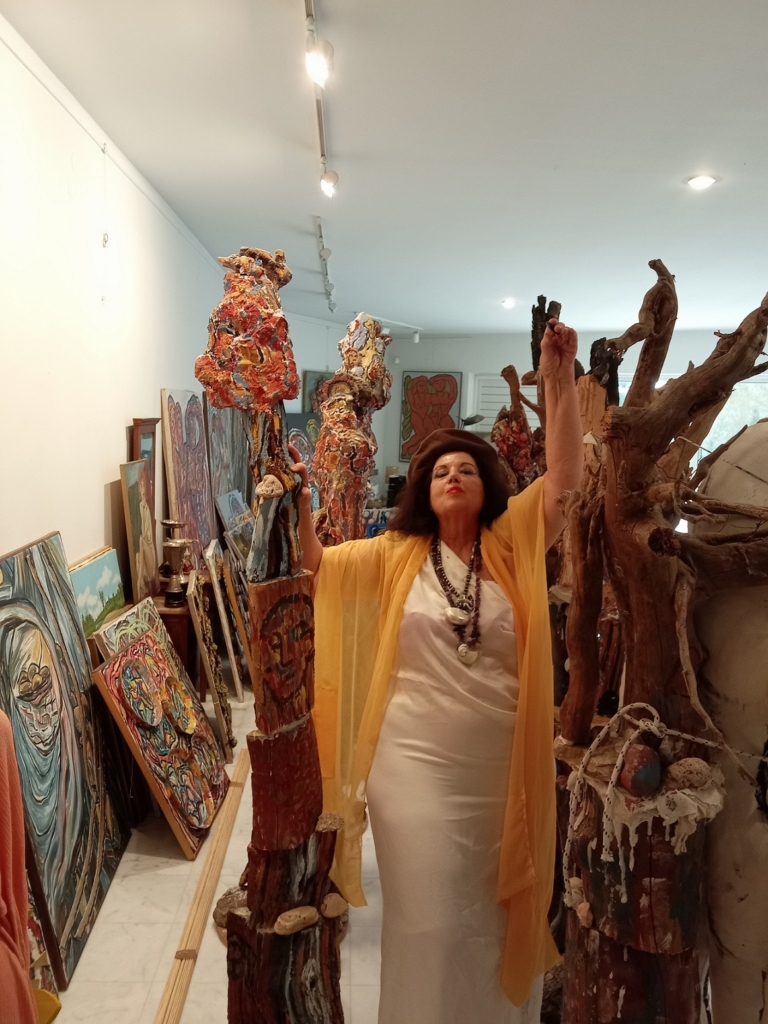
Eclettica, dinamica, entusiasta, il suo carattere perfettamente conforme all’esuberanza greca e le sue origini miste, sua madre era di Atene mentre suo padre era nato a Kiev, sono stati tasselli che hanno determinato il suo destino, quello di non fermarsi a una vita statica bensì di spingersi verso una conoscenza e una sperimentazione maggiore che l’ha portata a voler studiare in Italia, la culla dell’arte, per seguire la vocazione verso l’espressione della sua creatività. Il suo percorso inizia con gli studi presso la scuola di arti decorative di Doxiad di Atene ma poi si trasferisce a Roma per diplomarsi all’Accademia di Belle Arti di Roma seguendo i corsi di Pittura e stampa tenuti da alcuni tra i maggiori esponenti dell’arte moderna italiana di quel vivace periodo tra il 1965 e il 1969: Renato Guttuso, Franco Gentilini, Nino Maccari. Il contatto con questi grandi maestri e il suo intuito artistico la spingono a elaborare un suo stile personale fatto non solo di sperimentazione ma anche di necessità di legarsi alla materia, elemento solido, concreto, attraverso il quale infonde solidità alle sue opere, in alcuni casi vere e proprie pittosculture, necessarie a sottolineare la sua innata attenzione nei confronti di tutte quelle energie intangibili che aleggiano intorno all’individuo e alla sua esistenza quotidiana e che emergono solo in virtù di una forte sensibilità e capacità di guardare oltre l’apparenza. Rientrata ad Atene apre un suo studio artistico, inaugurato con la presenza dell’Ambasciatore italiano, e nel quale continua a percorrere il suo approfondimento creativo, di studio di tutto ciò che pur non appartenendo alla quotidianità tuttavia esiste, trova un suo modo per manifestarsi ed essere presente, induce e conduce l’artista a spingersi verso una conoscenza superiore, verso una consapevolezza che può generarsi solo attraverso l’ascolto, l’apertura e il desiderio di andare in fondo a sensazioni ed emozioni. I colori e la materia si amalgamano costituendo un completamento vicendevole, come se nel mondo della Netsayef non potesse esistere una vita senza quell’arcobaleno cromatico che, secondo le linee guida dell’Espressionismo Astratto, corrisponde e si armonizza con tutto il vortice interiore del sentire, divenendo possibilità di far sentire la propria voce non più attraverso le parole bensì con l’immediatezza di ciò che viene visto. La spiritualità dunque è mezzo di conoscenza e di esplorazione, di annullamento di quelle divisioni terrene, di quei limiti posti dalla ragione che invece il sentire emozionale non conosce, tanto quanto la materia diventa strumento di ricerca che induce l’artista a spingersi nelle pieghe più solide costituenti la base da cui poi spingersi verso il contatto con le energie sottili, e l’osservatore a riflettere su quei mondi paralleli, su quegli uomini e donne ritratti dalla Netsayef e contraddistinti solo dalla struttura esterna, per svelare quanto la categorizzazione, la catalogazione e la distinzione siano solo formalità inutili perché in fondo la vera essenza si trova nell’anima. Questo è quanto emerge dall’opera Persone dell’Universo 2
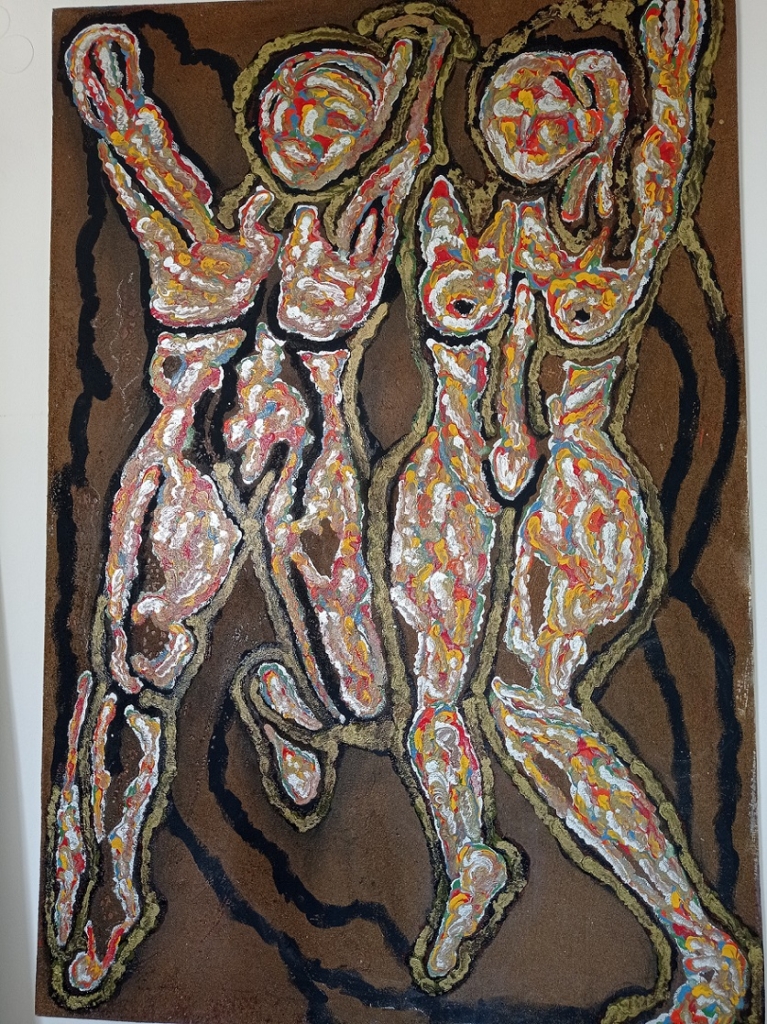
dove la delimitazione esterna è riempita da macchie colorate che rappresentano le sensazioni, il vero sé di ogni individuo, ed è solo quello in fondo ciò che davvero conta nel corso dell’esistenza; Elena Netsayef conduce l’osservatore a meditare su quanto spesso si dia rilevanza all’apparenza, a quella patina esterna e superficiale, non considerando quanto essa sia effimera rispetto invece alla sostanza, a tutto ciò che non potrà mai dissolversi. Quando parla però dell’Universo
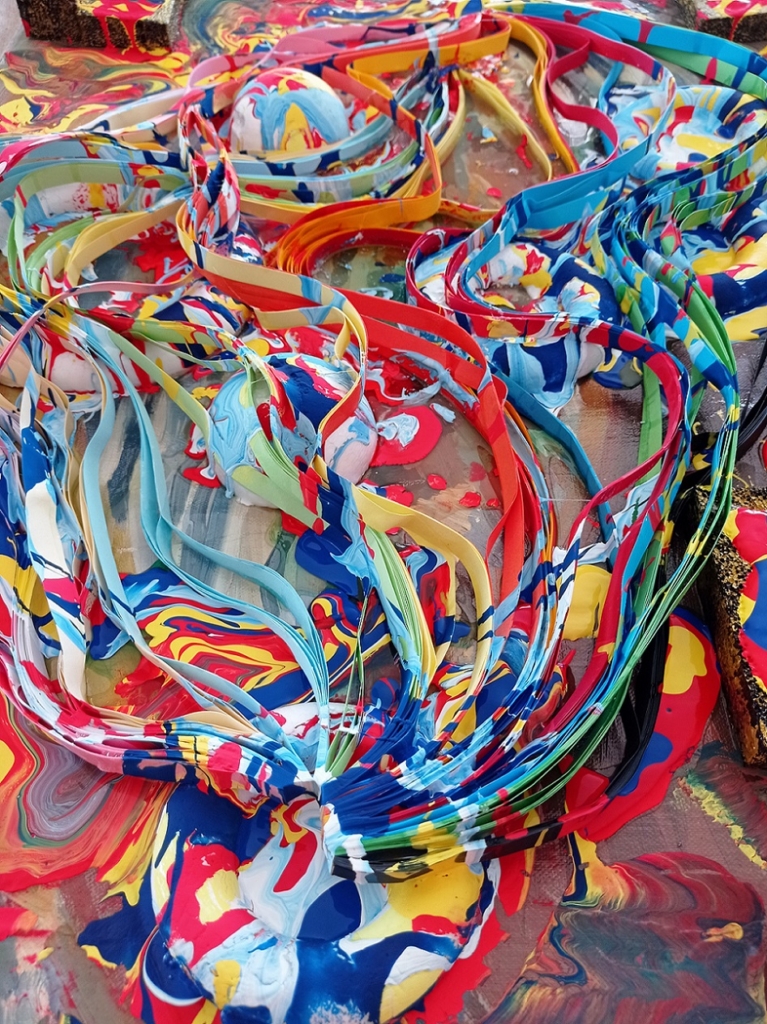
l’artista non può fare a meno di mostrarne tutta la gamma di tonalità che corrispondono alle infinite possibilità, alle opzioni che proprio in virtù dell’apertura e della capacità di allinearsi alle proprie energie interiori, possono diventare realtà; ciò che sottolinea la Netsayef è che tutto ciò che siamo e abbiamo dipende solo ed esclusivamente dal nostro atteggiamento e dalla nostra capacità di attrarre quelle energie trasformandole nella realtà che vogliamo. Conosciamo ora meglio questa eccentrica artista.
Elena, lei ha origini greche e ucraine, quanto pensa che questo abbia contato nel determinare la sua spinta a esplorare un mondo diverso da quello che conosceva, nel caso specifico l’Italia, e a realizzare il suo sogno artistico? E quanto l’esuberanza greca e la riflessività russa hanno influito nella formazione del suo carattere e nel suo stile creativo?
Tutti in famiglia eravamo artisti. Mia nonna Eleni aveva un suo atelier in pieno centro di Atene in cui realizzava abiti per il teatro; mia madre Maria cantava e disegnava; mio padre Costantino era ingegnere ma anche pittore. Sono cresciuta ascoltando le storie sulla rivoluzione russa del 1917 e questo mi ha fatto appassionare alla parte tragica della storia delle mie origini e anche dell’umanità perché mia nonna ha combattuto in quella battaglia sociale prendendosi cura di mio padre che aveva solo sei anni; era una donna forte che ha costituito per me un modello e una fonte di ispirazione, dotata di un carattere saggio, creativo e anche fortemente emotivo. Mi esortava a tenere sempre con me il suo amore, che mi avrebbe accompagnata nella vita. L’essere nata ad Atene mi ha fatta appassionare della filosofia antica, percorrendo nella mia età giovanile le strade in cui si incontravano i grandi pensatori immaginando di rivolgere a loro i miei pensieri e quesiti esistenziali. Mi sono sempre interrogata sui misteri dell’universo e anche su me stessa, mettendomi in discussione per diventare più coraggiosa, più saggia e lasciarmi andare alle energie sottili. Dunque la parte greca ha influenzato il mio lato filosofico, di ascolto e di riflessione sull’universo, mentre la mia parte russa la capacità di lasciarmi andare alla creatività senza vincoli razionali e l’amore innato per l’arte e per la cultura che hanno costituito una delle basi della mia vita.
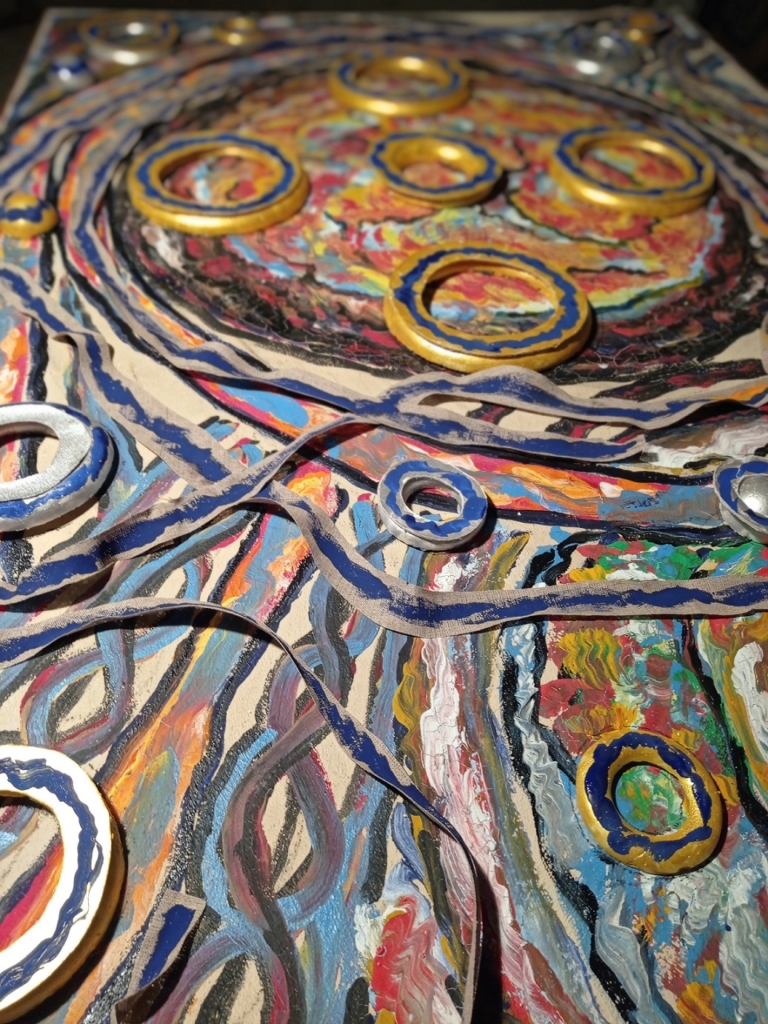
Il suo stile è riconducibile all’Espressionismo Astratto e anche all’Espressionismo a cui però non può fare a meno di aggiungere la materia. Cosa desidera trasmettere con le sue opere? Quale messaggio si nasconde dietro le sue immagini indefinite ma piene di colore e di sostanza?
Sono molto orgogliosa di essere riuscita ad arrivare ad essere riconducibile alla corrente espressionista; nel corso della mia crescita come artista ho scalato le montagne, strappato tele, lavorato tantissimo e anche pianto molto perché l’Espressionismo deve coinvolgere l’artista prima dell’osservatore. È uno stile che trasmette sentimenti, emozioni, poiché viene raccontata l’anima, l’interiorità e anche il dolore se si vogliono produrre opere di valore; bisogna prendere per mano il fruitore e coinvolgerlo all’interno di un mondo e di un punto di vista diverso dal suo, che altrimenti non conoscerebbe, trasportandolo in una dimensione lontana da quella della realtà attuale e dalla tristezza delle guerre. L’arte in questo è fondamentale perché innalza la conoscenza e la capacità emozionale, diventa educativa, arriva all’anima e alla mente, fa riflettere, aiuta le persone a evolvere attraverso l’avvicinamento a un mondo, quello creativo, che le porta a meditare e a trovare un modo di vivere migliore. È questo che vorrei arrivasse con le mie opere. Mi piace trasmettere l’amore che sento dentro di me quando comincio a creare e che cerco di tradurre con un’esplosione di colori, non mi interessa il lato commerciale, quello è una conseguenza ma nel momento in cui comincio a lavorare su una tela mi sento felice perché realizzo me stessa esprimendomi sia dal punto di vista filosofico e dunque mentale, sia da quello emotivo. La mia fonte di ispirazione è la natura, quella del microcosmo e quella del macrocosmo e la filosofia dà ordine ai miei pensieri permettendomi di raggiunger l’equilibrio necessario a far esplodere sulla tela le mie sensazioni.
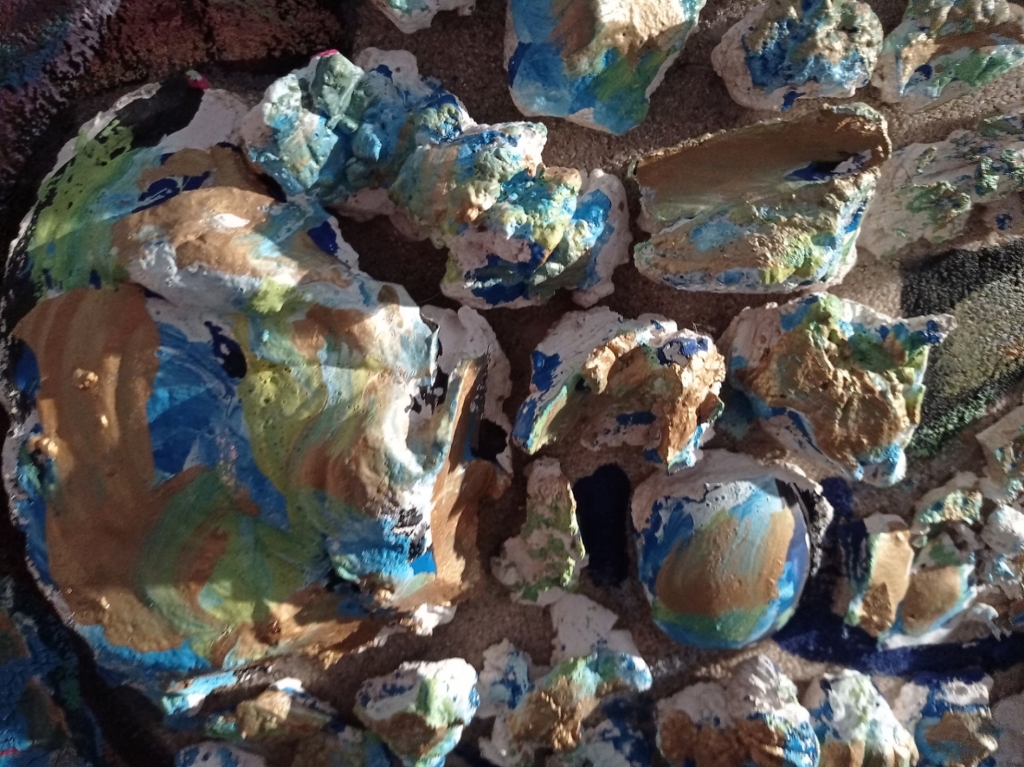
Lei ha avuto il privilegio di conoscere alcuni tra i maggiori artisti italiani del Novecento, qual è stato l’insegnamento più prezioso che ha ricevuto da loro? Quali sono le differenze tra il fare arte oggi rispetto al secolo scorso?
Il periodo durante il quale ho studiato a Roma credo sia stato il più felice della mia vita perché ero elettrizzata dal conoscere e dallo studiare con professori tanto importanti: Gentilini, Guttuso, Montanarini, Maccari. A quei tempi amavo socializzare e non appena uscivo dall’aula di lezione giravo tutta l’accademia con un entusiasmo che colpiva non solo i miei amici e compagni di studi ma anche i professori stessi, grandi personaggi tutti incisi nel mio cuore perché mi hanno dato tanto. Da Gentilini ho preso lo spunto di utilizzare la sabbia, uno dei suoi materiali preferiti, che contraddistingue tutte le mie opere, da Guttuso ho appreso a prediligere le opere di grandi dimensioni e l’uso dei colori forti e vivaci. Tutti loro mi hanno insegnato a lavorare duro per ottenere i risultati e a conoscere la storia dell’arte per poter creare un mio stile identificativo, affine alla mia naturale inclinazione, oltre a non smettere mai di approfondire la conoscenza di me stessa e
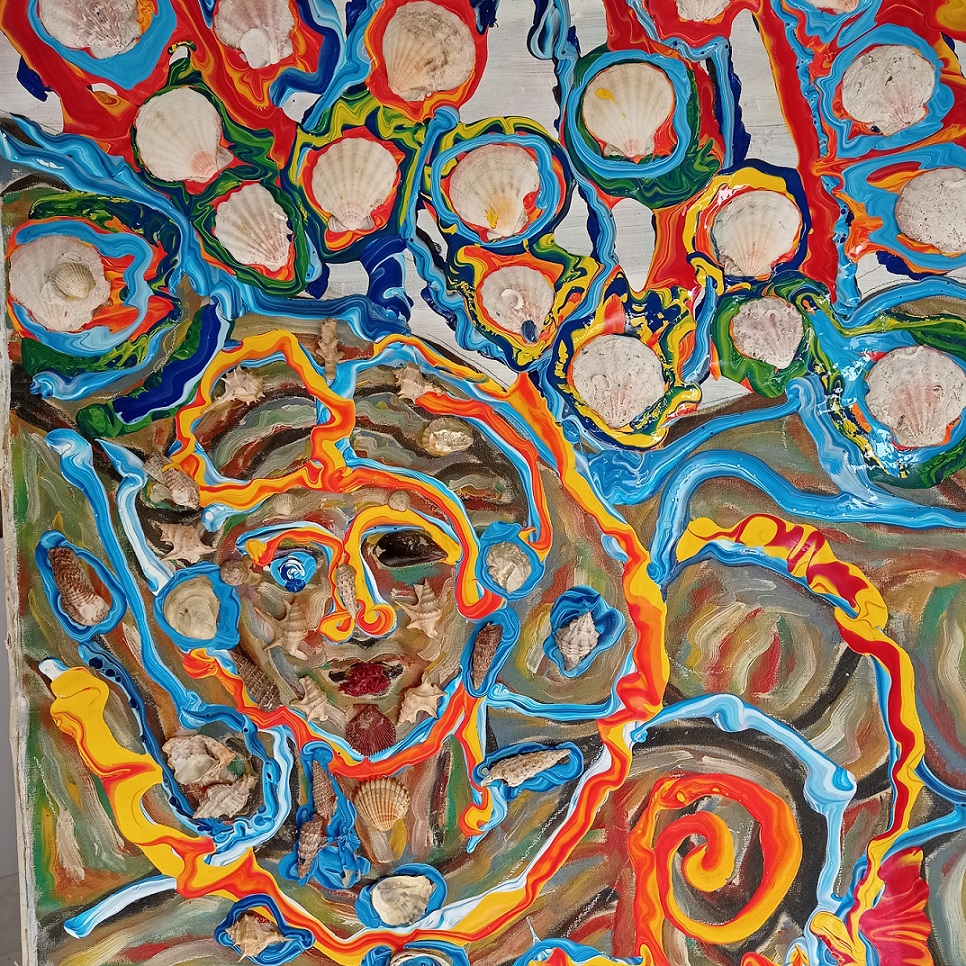
Crede che il viaggio, inteso come scoperta e conoscenza di tutto ciò che è diverso dall’ambiente in cui si è cresciuti, sia importante per la formazione individuale e artistica? Quanto è stato essenziale per lei entrare in contatto con culture diverse nell’elaborare il suo approccio filosofico all’arte?
Viaggiare è fondamentale perché l’artista deve essere universale, deve essere capace di lasciarsi influenzare e prendere qualcosa da ogni cultura, da ogni civiltà, mescolando diverse caratteristiche per dar vita a un linguaggio che vada oltre le differenze o che, per meglio dire, le unisca. L’arte e la cultura non creano guerre, lotte, bensì uniscono perché allontanano l’individuo dalle bassezze della non conoscenza elevandolo; il mio linguaggio pittorico si basa proprio sull’armonia e le emozioni che giungono a tutte le persone da qualunque parte del mondo provengano e in qualsiasi cultura siano cresciute.
Ha all’attivo mostre collettive in tutto il mondo e più di dieci mostre personali, ci racconta quali sono i suoi prossimi progetti?
L’arte mi ha dato tantissimo, mi ha insegnato a canalizzare le mie emozioni e a lasciar emergere le sensazioni di pace, amore, pazienza, speranza che ancora oggi contraddistinguono la mia personalità e il mio approccio alla vita. Ho lavorato molto, a volte ho anche accettato di svolgere dei lavori diversi per mantenere la mia arte che però non ho mai considerato con un fine commerciale. Il mio progetto è quello di continuare a esporre in tutto il mondo per conoscere persone diverse e lasciare che entrino nel mio universo artistico per farsene conquistare in maniera intuitiva e spontanea perché in fondo, come mi piace sempre dire, l’arte è un messaggio dell’anima.
ELENA NETSAYEF-CONTATTI
Email: elena.netsayef@gmail.com
Facebook: https://www.facebook.com/profile.php?id=100015648882106
Instagram: https://www.instagram.com/netsayef/
Marta Lock’s interviews:
Elena Netsayef, a life of art to deepen the subtle energies around the individual
Eclectic, dynamic, enthusiastic, her character perfectly in tune with Greek exuberance and her mixed origins – her mother was from Athens while her father was born in Kiev – were pieces that determined her destiny, that of not stopping at a static life but of pushing herself towards greater knowledge and experimentation that led her to want to study in Italy, the cradle of art, to follow her vocation towards the expression of her creativity. Her path began with her studies at the Doxiad School of Decorative Arts in Athens, but then she moved to Rome to graduate from the Academy of Fine Arts, taking courses in painting and printmaking taught by some of the leading exponents of modern Italian art in that lively period between 1965 and 1969: Renato Guttuso, Franco Gentilini, Nino Maccari. Her contact with these great masters and her artistic intuition led her to elaborate her own personal style made up not only of experimentation but also of the need to bind herself to matter, a solid, concrete element through which she infuses her artworks, in some cases veritable pictosculptures, with solidity, necessary to emphasise her innate attention to all those intangible energies that hover around the individual and his daily existence and that emerge only by virtue of a strong sensitivity and ability to look beyond appearances. Back in Athens, she opened her own artistic studio, inaugurated with the presence of the Italian Ambassador, and in which she continues to pursue her creative investigation, the study of everything that, although not belonging to everyday life, nevertheless exists, finds its own way to manifest itself and be present, induces and leads the artist to push herself towards a higher knowledge, towards an awareness that can only be generated through listening, openness and the desire to get to the bottom of sensations and emotions. Colours and matter amalgamate constituting a mutual completion, as if in Netsayef’s world no life could exist without that chromatic rainbow which, according to the guidelines of Abstract Expressionism, corresponds to and harmonises with the whole inner vortex of feeling, becoming the possibility of making one’s own voice heard no longer through words but through the immediacy of what is seen. Spirituality, therefore, is a means of knowledge and exploration, of cancelling those earthly divisions, those limits set by reason that emotional feeling does not know, as much as matter becomes an instrument of research that induces the artist to push herself into the most solid folds constituting the basis from which she can then push towards contact with subtle energies, and the observer to reflect on those parallel worlds, on those men and women portrayed by Netsayef and distinguished only
by their external structure, to reveal how categorisation, cataloguing and distinction are only useless formalities because after all, the true essence lies in the soul. This is what emerges from the artwork People of the Universe 2 where the external delimitation is filled with coloured spots that represent the sensations, the true self of each individual, and it is only that in the end that really counts in the course of existence; Elena Netsayef leads the observer to meditate on how much importance is often given to appearance, to that external and superficial patina, not considering how ephemeral it is compared instead to the substance, to everything that can never dissolve. When she speaks, however, of the Universe, the artist cannot help but show the whole range of tones that correspond to the infinite possibilities, to the options that, precisely by virtue of openness and the ability to align with one’s inner energies, can become reality; what Netsayef emphasises is that everything we are and have depends solely and exclusively on our attitude and our ability to attract those energies, transforming them into the reality we want. Let us now get to know this eccentric artist better.
Elena, you have Greek and Ukrainian origins, how much do you think this has counted in determining your drive to explore a world other than the one you knew, in this case Italy, and to realise your artistic dream? And how much did Greek exuberance and Russian reflexivity influence the formation of your character and creative style? Everyone in my family was an artist. My grandmother Eleni had her own atelier in the centre of Athens where she made clothes for the theatre; my mother Maria sang and drew; my father Constantine was an engineer but also a painter. I grew up listening to stories about the Russian Revolution of 1917 and this made me passionate about the tragic part of the history of my origins and also of humanity because my grandmother fought in that social battle taking care of my father when he was only six years old; she was a strong woman who was a role model and source of inspiration for me, endowed with a wise, creative and also strongly emotional character. She urged me to always keep her love with me, which would accompany me through life. Being born in Athens made me passionate about ancient philosophy, walking in my youth through the streets where the great thinkers met, imagining myself addressing my thoughts and existential questions to them. I have always wondered about the mysteries of the universe and also about me, questioning myself in order to become braver, wiser and let go of the subtle energies. So the Greek side influenced my philosophical side, of listening and reflecting on the universe, while my Russian side influenced my ability to let myself go to
creativity without rational constraints and my innate love for art and culture, which formed one of the foundations of my life.
Your style can be traced back to Abstract Expressionism and also to Expressionism to which, however, you cannot help but add matter. What do you wish to convey with your artworks? What message lies behind your undefined but colourful and substantive images?
I am very proud that I have been able to be ascribed to the Expressionist current; in the course of my growth as an artist, I have climbed mountains, ripped canvases, worked a lot and even cried a lot because Expressionism must involve the artist before the observer. It is a style that conveys feelings, emotions, because the soul, interiority and even pain need to be told if you want to produce works of value; you have to take the viewer by the hand and involve him in a world and a point of view different from their own, which they would otherwise not know, transporting them to a dimension far removed from that of current reality and the sadness of wars. Art is fundamental in this because it raises knowledge and emotional capacity, it becomes educational, it reaches the soul and the mind, it makes people reflect, it helps them evolve through approaching a world, the creative world, which leads them to meditate and find a better way of living. This is what I would like to achieve with my artworks. I like to convey the love I feel inside me when I start to create and which I try to translate with an explosion of colours, I am not interested in the commercial side, that is a consequence but the moment I start to work on a canvas I feel happy because I realise myself by expressing both from a philosophical and therefore mental point of view, and from an emotional one. My source of inspiration is nature, that of the microcosm and that of the macrocosm, and philosophy gives order to my thoughts, allowing me to achieve the balance necessary to make my feelings explode on canvas.
You had the privilege of getting to know some of the greatest Italian artists of the 20th century, what was the most valuable teaching you received from them? What are the differences between making art today and the last century? The period during which I studied in Rome I believe was the happiest of my life because I was thrilled to know and study with such important professors: Gentilini, Guttuso, Montanarini, Maccari. In those days I loved socialising and as soon as I left the lecture room I would walk around the academy with an enthusiasm that impressed not only my friends and
fellow students but also the professors themselves, great personalities all engraved in my heart because they gave me so much. From Gentilini I took the cue to use sand, one of his favourite materials, which characterises all my works, from Guttuso I learnt to prefer large artworks and the use of strong, bright colours. All of them taught me to work hard to achieve results and to know the history of art in order to create my own identifying style, akin to my natural inclination, as well as to never stop learning about myself and experimenting.
Do you believe that travelling, in the sense of discovering and getting to know everything that is different from the environment in which one grew up, is important for individual and artistic training? How essential was it for you to come into contact with different cultures in developing your philosophical approach to art?
Travelling is fundamental because the artist must be universal, he must be able to let himself be influenced and take something from every culture, from every civilisation, mixing different characteristics to create a language that goes beyond differences or, better said, mixes them. Art and culture do not create wars, struggles, but rather unite because they remove the individual from the baseness of non-knowledge by elevating him; my pictorial language is based precisely on harmony and emotions that reach all people from whatever part of the world they come from and in whatever culture they have grown up.
You have group exhibitions all over the world and more than ten solo exhibitions to your credit, can you tell us what are your next projects?
Art has given me so much, it has taught me how to channel my emotions and let the feelings of peace, love, patience, hope emerge that still characterise my personality and my approach to life. I have worked a lot, sometimes even taking on different jobs to maintain my art, but I have never considered it with a commercial purpose. My plan is to continue exhibiting all over the world to meet different people and let them enter my artistic universe to be won over intuitively and spontaneously because after all, as I always like to say, art is a message of the soul.
